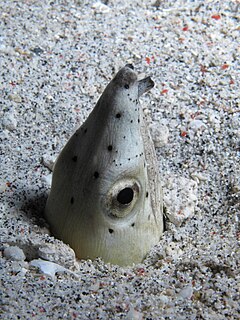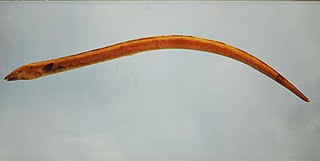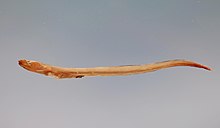
Moringua edwardsi, the common spaghetti eel, is an eel in the family Moringuidae. It was described by David Starr Jordan and Charles Harvey Bollman in 1889, originally under the genus Stilbiscus. It is a subtropical, marine eel known from the western Atlantic Ocean, including Antigua and Barbuda, Aruba, the Bahamas, Barbados, Belize, Bermuda, Cuba, Dominica, Grenada, Guadeloupe, Honduras, Jamaica, Martinique, Mexico, Montserrat, Nicaragua, Puerto Rico, Saint Kitts and Nevis, Saint Lucia, Saint Vincent and the Grenadines, Trinidad and Tobago, Florida, Venezuela, the Virgin Islands, British, and the Virgin Islands of the United States. Males can reach a maximum total length of 15 cm, while females can reach a maximum of 50 cm. The eels feed primarily off of burrowing invertebrates.
The flapnose conger is an eel in the family Congridae. It was described by David G. Smith and Robert H. Kanazawa in 1977. It is a tropical, marine eel which is known from French Guiana, in the western central Atlantic Ocean. It is known to dwell at a depth of 210 metres.
The Californian conger, also known as the ringeye conger, is an eel in the family Congridae. It was described by Robert H. Kanazawa. It is a tropical, marine eel which is known from the eastern central and southeastern Pacific Ocean, including Colombia, Costa Rica, Ecuador, El Salvador, Guatemala, Honduras, Mexico, Nicaragua, Panama, and Peru. It is known to dwell at a depth of 50 metres. Males reach an average total length of 40 centimetres, but can reach a maximum TL of 60 cm.
Gnathophis bracheatopos, the longeye conger, is an eel in the family Congridae. It was described by David G. Smith and Robert H. Kanazawa in 1977. It is a tropical, marine eel which is known from the United States and the eastern Gulf of Mexico, in the western Atlantic Ocean. It dwells at a depth range of 55–110 meters. Males can reach a maximum total length of 35 centimeters.
Apterichtus kendalli, the Western Atlantic finless eel or finless eel, is an eel in the family Ophichthidae. It was described by Charles Henry Gilbert in 1891. It is a marine, subtropical eel which is known from the western and eastern Atlantic Ocean, including North Carolina, USA; the western Bahamas, Venezuela, and St. Helena Island. It dwells at a depth range of 3 to 400 metres, and forms burrows in sandy sediments on the continental shelf. Males can reach a maximum total length of 60 centimetres (24 in).

The highfin snake eel (Ophichthus altipennis, also known as the blackfin snake eel or the black-finned snake eel, is an eel in the family Ophichthidae. It was described by Johann Jakob Kaup in 1856, originally under the genus Microdonophis. It is a marine, tropical eel known from the eastern Indian Ocean and northwestern and western central Pacific Ocean, including Australia, French Polynesia, Indonesia, Japan, the Marshall Islands, Malaysia, the Philippines, and Papua New Guinea. It dwells at a depth range of 0 to 40 m, and forms burrows in soft inshore sand sediments. Males can reach a maximum total length of 103 cm.
The thin snake eel is an eel in the family Ophichthidae. It was described by John E. McCosker and Richard Heinrich Rosenblatt in 1998. It is a marine, tropical eel known from the eastern central and southeastern Pacific Ocean, including Mexico and Colombia. It is known from two specimens observed dwelling in sand at a depth range of 0 to 8 m. The maximum length recorded was 23.1 cm (9.1 in), albeit on an immature specimen.
The dusky snake eel is an eel in the family Ophichthidae. It was described by Camillo Ranzani in 1839. It is a tropical, marine eel which is known from the western Atlantic Ocean, including Cuba and Brazil.
The death-banded snake-eel is an eel in the family Ophichthidae. It was described by Samuel Garman in 1899. It is a tropical, marine eel which is known from the eastern central and southeastern Pacific Ocean, including the central Gulf of California, Colombia, Costa Rica, Mexico and Panama. It dwells at a depth range of 35–760 metres, and forms burrows in sandy and muddy bottoms. Males can reach a maximum total length of 86 centimetres.

The shrimp eel is an eel in the family Ophichthidae. It was described by Francis de Laporte de Castelnau in 1855. It is a common inshore species of eel usually found in the shallow Gulf of Mexico and the high-salinity bays where it inhabits muddy habitats.
Ophichthus longipenis, known commonly as the slender snake eel in Mexico, is an eel in the family Ophichthidae. It was described by John E. McCosker and Richard Heinrich Rosenblatt in 1998. It is a marine, tropical eel which is known from the eastern central Pacific Ocean, including Mexico, El Salvador, Guatemala, Honduras, Nicaragua, Costa Rica and Panama. It dwells at a depth range of 0 to 69 metres, and inhabits sand sediments. Males can reach a maximum total length of 58.7 centimetres (23.1 in).
The longarmed snake eel is an eel in the family Ophichthidae. It was described by John E. McCosker and Richard Heinrich Rosenblatt in 1998. It is a marine, tropical eel which is known from the eastern central Pacific Ocean, including Mexico, Costa Rica, El Salvador, Guatemala, Nicaragua, and Panama. It is known to dwell at a depth range of 24 to 79 metres, and inhabits soft substrates. Males can reach a maximum total length of 27.4 centimetres (10.8 in).
Ophichthus melope is an eel in the family Ophichthidae. It was described by John E. McCosker and Richard Heinrich Rosenblatt in 1998. It is a marine, tropical eel which is known from the eastern central and southeastern Pacific Ocean, including Colombia and Costa Rica. It dwells at a depth range of 100 to 224 metres. Males can reach a maximum total length of 27 centimetres (11 in).

The punctuated snake-eel is an eel in the family Ophichthidae. It was described by Achille Valenciennes in 1837, originally under the genus Ophisurus. It is a marine, subtropical eel which is known from the eastern central and southeastern Pacific Ocean, including Nicaragua, Chile, Colombia, Costa Rica, Ecuador, Peru, and Panama. It dwells at a depth range of 15 to 277 metres, and inhabits sand and mud sediments. Males can reach a maximum total length of 85 centimetres (33 in), but more commonly reach a TL of 60 centimetres (24 in).
The rufus snake-eel is an eel in the family Ophichthidae. It was described by Constantine Samuel Rafinesque in 1810, originally under the genus Echelus. It is a marine, subtropical eel which is known from throughout the Mediterranean and the Black Sea, in the northeastern Atlantic Ocean, including Algeria, Albania, Croatia, Egypt, France, Cyprus, Gibraltar, Greece, Italy, Israel, Montenegro, Lebanon, Libya, Malta, Morocco, Monaco, Slovenia, Spain, Tunisia, the Syrian Arab Republic, and Turkey. It inhabits mud sediments on the continental shelf. Males can reach a maximum total length of 60 centimetres (24 in).
The wrinkled snake-eel is an eel in the family Ophichthidae. It was described by David Starr Jordan and Charles Harvey Bollman in 1890. It is a marine, tropical eel which is known from the eastern central and southeastern Pacific Ocean, including the Galapagos Islands and the Cocos Islands. It is also speculated to occur in Malpelo Island. It is known to dwell at a depth of 200 metres (660 ft), and inhabits sediments of sand and rubble. Males can reach a maximum total length of 68 centimetres (27 in).

The Pacific snake-eel is an eel in the family Ophichthidae. It was described by Johann Jakob Kaup in 1856, originally under the genus Muraenopsis. It is a marine, subtropical eel which is known from the eastern central and southeastern Pacific Ocean, including California, USA, Peru, the Gulf of California, Mexico, the Galapagos Islands, Colombia, Ecuador, Costa Rica, El Salvador, Honduras, Guatemala, Nicaragua, and Panama. It dwells at a maximum depth of 155 metres (509 ft), and forms burrows in mud and sand sediments. Males can reach a maximum total length of 115 centimetres (45 in), but more commonly reach a TL of 80 centimetres (31 in).
The yellow snake-eel is an eel in the family Ophichthidae. It was described by David Starr Jordan and Charles Henry Gilbert in 1882. It is a marine, subtropical eel known from the eastern central and southeastern Pacific Ocean, including Chile, Costa Rica, Colombia, Ecuador, Guatemala, El Salvador, Honduras, Nicaragua, Mexico, Panama, Peru, and the United States. It dwells at a depth range of 1 to 110 m, and forms burrows in rocky and sandy regions. Males can reach a maximum total length of 818 cm (322 in), but more commonly reach a length of 540 cm (210 in).
The short-tooth sawpalate is an eel in the family Serrivomeridae. It was described by Johannes Schmidt in 1916, originally under the genus Leptocephalus. It is a marine, deep water-dwelling eel which is known from the eastern central and western central Atlantic Ocean, including the Bahamas and Bermuda, as well as the Strait of Gibraltar, Cape Verde, Canada and the United States. It dwells at a depth range of 150 to 1,000 metres. Males can reach a maximum total length of 65 centimetres (26 in).
The Kaup's arrowtooth eel is an eel in the family Synaphobranchidae. It was described by James Yate Johnson in 1862. It is a marine, deep water-dwelling eel which is known from the Indo-Western Pacific and eastern and western Atlantic Ocean, including the Faroe Islands, Iceland, Cape Verde, the Western Sahara, Nigeria, Namibia, South Africa, Greenland, France, Saint Pierre and Miquelon, the United Kingdom, Ireland, the Philippines, Portugal, Spain, the Bahamas, Brazil, Canada, Cuba, Japan, Australia, Mauritania, Morocco, and Hawaii. It dwells at a depth range of 120 to 4,800 metres, most often between 400 to 2,200 metres, and inhabits the upper abyssal zone on the continental slope. It is intolerant of the temperatures of higher waters. Males can reach a maximum total length of 100 centimetres (39 in).





